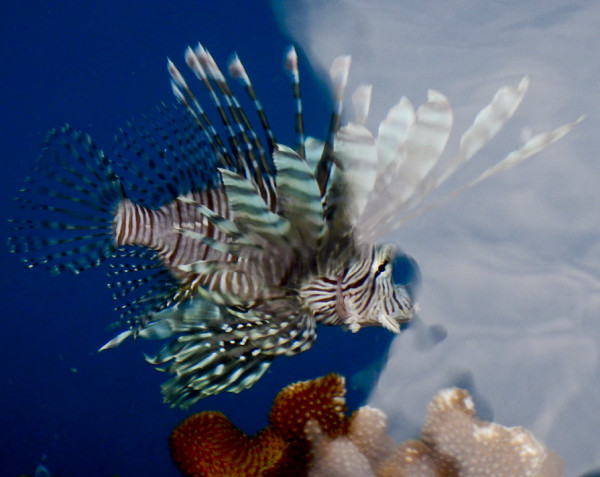Published in the Ocean Watch column, Honolulu Star-Advertiser © Susan Scott
August 19, 2013
PAPEETE, TAHITI » For days I admired a pipefish from the deck of my boat, Honu, in this marina where the water is gin clear to 50 feet. The 6-inch-long yellow-banded pipefish was a nervous little thing that spent much of its time hovering behind the rungs of a ladder attached to the dock.
Occasionally the fish ventured out in search of food, drifting crustaceans and fish larvae. But if my shadow darkened the water or my gangplank clunked with a wave, the little pipefish dashed back to its protective rungs.
I was thrilled to have my own pipefish to admire because I’ve never seen any of Hawaii’s six species, which live in deep water, hide in dark caves or hover among camouflaging seaweeds. Like sea horses, pipefish blend so well with their environment that you can look right at one and still not see it.
 A lion fish, not found in Hawaii, hunted near the deck of the Honu when it was in Tahiti.
A lion fish, not found in Hawaii, hunted near the deck of the Honu when it was in Tahiti.
©2013 Susan Scott
I mention sea horses because the two are close relatives. Both have long, tubelike snouts that inhale their prey, are slow swimmers and have eyes that move independently to better spot tiny food items. The pipefish resembles a stretched-out sea horse, except it has a skinnier body, fanlike tail and is often decked out in colorful stripes, spots and rings.
Like sea horses, after an elaborate courtship dance, a female pipefish deposits her eggs into her partner’s pouch where he fertilizes them and carries the eggs to hatching. Some males just can’t stop dancing. Researchers have found male pipefish simultaneously carrying the eggs of three females.
As I mentioned last week, while walking my gangplank I nearly fell in the water over the appearance of a 15-inch-long lion fish, its fins nearly breaking the water’s surface. This stunning carnivore is native from Australia to the Marquesas, and from Japan to New Zealand, but is not found in Hawaii.
Lion fish weren’t found in the Atlantic, either, until humans gave them a lift. The species, Pterois volitans, is now common from Florida to New York and Bermuda where it preys on native fish not adapted to this crackerjack stalker.
But even those that know the danger can be in trouble when a lion fish goes hunting.
Slowly my lion fish swept the coral wall along my dock, fanning its lovely, venomous fins to flush out small fish and invertebrates.
It’s a sight to behold under any circumstances, but that fish gave me time to fetch my camera, shoot some pictures and still have minutes to marvel.
It also, I think, ate my pipefish. I never saw it again.
I consider my pipefish and lion fish sightings as extraordinary gifts from the South Pacific. And I haven’t even left the dock yet.